The British Empire went through phases of colonization: the first spanned from 1583 to 1783, the second from 1783 to 1815, an imperial period from 1815 to 1914, and a period of decline and decolonization from 1945 to 1997. The imperial period has been referred to as major European powers undergoing “empire for empire’s sake” and was marked by the purpose of economic profit and racial rankings of white Europeans as superior to people living in African, Caribbean, and Asian countries. Almost all colonized people were people of color, and oppression was justified because the colonizers saw themselves as “civilizing” and “Westernizing” the people of their colonies.
Reflecting these attitudes were the artistic works of the day, specifically written works like the “domestic novel.” The domestic novel focused on cementing the cultural ideas of what home life should look like: middle class, white, women staying at home to be submissive to their husbands and raise a family, and men being the key for securing a woman’s future. Through using this literature, European powers reinforced the idea of what society should look like, “educated” their colonies, and saw their actions as noble.
World War Two placed significant strain on England, leaving the country bombed and ruined. In 1947, England started decolonizing, starting with India’s independence. Then, England started inviting residents of their colonies to the Mother Country with promises of work (rebuilding the rubble of major cities). Immediately facing difficulties finding housing because of segregation, being forced into the bottom of England’s class system, and overcoming the sexism set in place by domestic ideas and theories, authors and artists of color have only recently gained attention for sharing their stories.
Some of the authors and artists featured on this site come from…
Nigeria
Located: West Africa bordering the Gulf of Guinea, between Benin in the west, Cameroon and Chad in the east, and Niger in the north
Colonized: The late 19th century; fully incorporated into a country under British rule in 1914
Gained Independence: 1960
Nigeria is currently the most populous country in Africa and archeological evidence suggests that human inhabitation started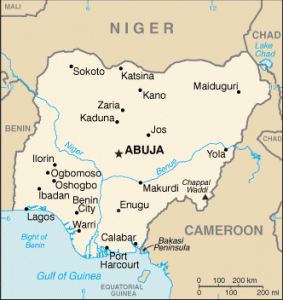 there in 9000 B.C.E. Britain used the colony for tin, coal, palm kernels and oil, cocoa, peanuts, rubber, and cotton. The Niger River delta was once a source of humans sold into slavery, too. Britain controlled the country through regional indigenous leaders they gave strong government power to, since there were too many ethnic groups in Nigeria for Britain to create a central government (New World Encyclopedia). Nigeria is a member of the Organization of Petroleum Exporting Countries (OPEC), but oil fortunes have been mismanaged or squandered via corruptive practices (World Factbook). After decolonization, military dictatorships were in power periodically until 1999. Nigeria was a founding member of the Organization for African Unity, which is now known as the African Union (New World Encyclopedia).
there in 9000 B.C.E. Britain used the colony for tin, coal, palm kernels and oil, cocoa, peanuts, rubber, and cotton. The Niger River delta was once a source of humans sold into slavery, too. Britain controlled the country through regional indigenous leaders they gave strong government power to, since there were too many ethnic groups in Nigeria for Britain to create a central government (New World Encyclopedia). Nigeria is a member of the Organization of Petroleum Exporting Countries (OPEC), but oil fortunes have been mismanaged or squandered via corruptive practices (World Factbook). After decolonization, military dictatorships were in power periodically until 1999. Nigeria was a founding member of the Organization for African Unity, which is now known as the African Union (New World Encyclopedia).
Saint Kitts and Nevis
Located: Leeward Islands in the West Indies
Colonized: Forcefully unified with Anguilla in the late 19th century
Gained Independence: 1983
The smallest island nation in the Americas, Saint Kitts and Nevis have one of the longest written histories of any island nation in 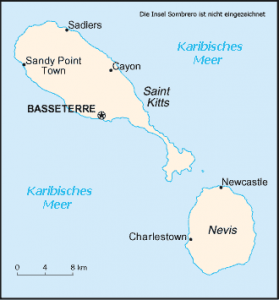 the Caribbean. It was first encountered by Europeans with the arrival of Christopher Columbus and sugar was the main export from the 1640s until 2005, when the government shut down the industry after decades-long poor harvests (New World Encyclopedia). The UK gave the territory of Saint Christopher-Nevis-Anguilla full internal autonomy in 1967, but Anguilla rebelled and seceded in 1971. Today, Saint Kitts and Nevis is an independent Commonwealth Realm with Great Britain’s royal head of the monarch acting as head of state. Nevis currently wants to separate from St. Kitts, but a 1998 referendum failed to get the two-thirds majority votes needed (World Factbook).
the Caribbean. It was first encountered by Europeans with the arrival of Christopher Columbus and sugar was the main export from the 1640s until 2005, when the government shut down the industry after decades-long poor harvests (New World Encyclopedia). The UK gave the territory of Saint Christopher-Nevis-Anguilla full internal autonomy in 1967, but Anguilla rebelled and seceded in 1971. Today, Saint Kitts and Nevis is an independent Commonwealth Realm with Great Britain’s royal head of the monarch acting as head of state. Nevis currently wants to separate from St. Kitts, but a 1998 referendum failed to get the two-thirds majority votes needed (World Factbook).
Jamaica
Located: West Indies in the Caribbean Sea, east of Nicaragua, south of Cuba, and west of Haiti
Colonized: 1707 (Captured by the British from the Spanish in 1655; formally ceded in 1670)
Gained Independence: 1962
Jamaica was originally reached by Christopher Columbus in 1494 and colonized by the Spanish. Starting in 1655, it became a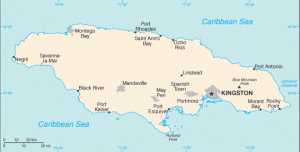 huge sugar colony fueled by slave labor for the British. Between 1820 to 1824, over 77,000 tons of sugar were produced there per year. Cocoa and coffee were also huge plantation crops (New World Encyclopedia). Along with other British colonies, Jamaica joined the Federation of the West Indies in 1958 but left in 1962 to gain full independence (World Factbook). Jamaica is especially important in postcolonial narratives because of the journey of the Empire Windrush from Kingston in London in 1948. The Windrush carried 492 passengers (and a debated amount of stowaways) from the West Indies. This prompted the start of immigration by people from formerly colonized lands to England, the “Mother Country.” The “Jamaican Diaspora” refers to the Jamaicans who left the West Indies in the later 20th century and reside outside the island (New World Encyclopedia).
huge sugar colony fueled by slave labor for the British. Between 1820 to 1824, over 77,000 tons of sugar were produced there per year. Cocoa and coffee were also huge plantation crops (New World Encyclopedia). Along with other British colonies, Jamaica joined the Federation of the West Indies in 1958 but left in 1962 to gain full independence (World Factbook). Jamaica is especially important in postcolonial narratives because of the journey of the Empire Windrush from Kingston in London in 1948. The Windrush carried 492 passengers (and a debated amount of stowaways) from the West Indies. This prompted the start of immigration by people from formerly colonized lands to England, the “Mother Country.” The “Jamaican Diaspora” refers to the Jamaicans who left the West Indies in the later 20th century and reside outside the island (New World Encyclopedia).
India
Located: Southern Asia, bordering Bhutan, China, Pakistan, Burma, Nepal, and Bangladesh
Colonized: 1858 (British rule thought to begin in 1757)
Gained Independence: 1947
The most populated liberal democracy in the world, the British East India company had been in India as early as 1619 (and previously, other European powers had footholds there dating from 1498). In 1757 in the Battle of Plassey, the British East India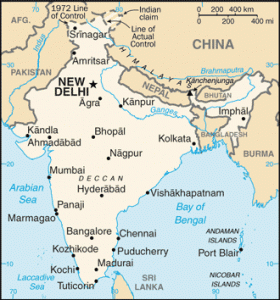 Company took over the Bengal region and monopolized trade. By the 1850s, the Indian subcontinent was controlled almost entirely by the British Raj. After an Indian rebellion in 1857, power was transferred from the Company to the British Crown (New World Encyclopedia). Through uprisings against the British Raj, provisional councils, Indian advisers in the British Viceroy, and the transformation of the Indian National Congress by leaders like Subhas Chandra Bose, Muhammad Ali Jinnah, Jawaharlal Nehru, and Mahatma Gandhi, India became the first country to declare freedom from the Empire in 1947 (World Factbook). The British partitioned India and two Muslim-majority areas were carved off into a new nation, Pakistan, with East and West wings. Currently, India has one of the world’s fastest growing economies, prompted by economic reforms in 1991, and is the homeland of 4 major religions: Sikhism, Buddhism, Jainism, and Hinduism. Since 1974, India has been a nuclear power and was a founding member of the Non-Aligned Movement at the United Nations (New World Encyclopedia).
Company took over the Bengal region and monopolized trade. By the 1850s, the Indian subcontinent was controlled almost entirely by the British Raj. After an Indian rebellion in 1857, power was transferred from the Company to the British Crown (New World Encyclopedia). Through uprisings against the British Raj, provisional councils, Indian advisers in the British Viceroy, and the transformation of the Indian National Congress by leaders like Subhas Chandra Bose, Muhammad Ali Jinnah, Jawaharlal Nehru, and Mahatma Gandhi, India became the first country to declare freedom from the Empire in 1947 (World Factbook). The British partitioned India and two Muslim-majority areas were carved off into a new nation, Pakistan, with East and West wings. Currently, India has one of the world’s fastest growing economies, prompted by economic reforms in 1991, and is the homeland of 4 major religions: Sikhism, Buddhism, Jainism, and Hinduism. Since 1974, India has been a nuclear power and was a founding member of the Non-Aligned Movement at the United Nations (New World Encyclopedia).
South Africa
Located: Southern tip of Africa, bordering Namibia, Botswana, Zimbabwe, Mozambique, Lesotho, and Swaziland
Colonized: Cape Colony was annexed by the British in 1805; the Union of South Africa was created in 1910
Gained Independence: Apartheid ended in 1994
First used by Europeans as a stopover point from the Far East to the Netherlands by Dutch traders in 1652, South Africa’s colonial history is marked by periodic wars for power fought by the British and Afrikaners (Dutch settlers who were also referred to as 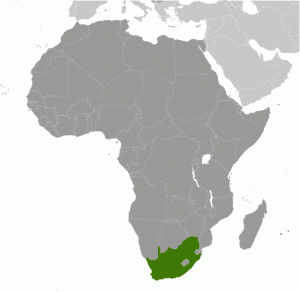 “Boers” by the British). Often, indigenous black residents had their lands taken when settlers pushed further north in the country, and were also exploited for labor for the gold and diamond industry (founded in 1867 and 1886, respectively). The Boers and British joined together to rule in 1910, and in 1948, Apartheid was put in place with the white minority ruling the black majority. After a white-only referendum, South Africa became a republic in 1961. Insurgencies, actions of the African National Congress (ANC) and leaders like Nelson Mandela, and worldwide boycotts prompted a negotiation for the stop of the regime and transition to a majority-rule government. Apartheid, which to this day has lasting impacts on the social welfare and mobility of black Africans, was ended in 1994. The ANC is currently in power (World Factbook).
“Boers” by the British). Often, indigenous black residents had their lands taken when settlers pushed further north in the country, and were also exploited for labor for the gold and diamond industry (founded in 1867 and 1886, respectively). The Boers and British joined together to rule in 1910, and in 1948, Apartheid was put in place with the white minority ruling the black majority. After a white-only referendum, South Africa became a republic in 1961. Insurgencies, actions of the African National Congress (ANC) and leaders like Nelson Mandela, and worldwide boycotts prompted a negotiation for the stop of the regime and transition to a majority-rule government. Apartheid, which to this day has lasting impacts on the social welfare and mobility of black Africans, was ended in 1994. The ANC is currently in power (World Factbook).
Bangladesh
Located: Southern Asia, in the eastern corner of the Bengal region. Borders the Bay of Bengal, India, and Myanmar
Colonized: Part of the British Raj on the Indian subcontinent from 1858 to 1947; partitioned into East Pakistan in 1947
Gained Independence: 1971
East Pakistan, now called Bangladesh, was part of the Bengal region and was originally a part of British India. The region was partitioned in 1947 (the year India gained independence). The partition, intended by the British to quell Muslim and Hindu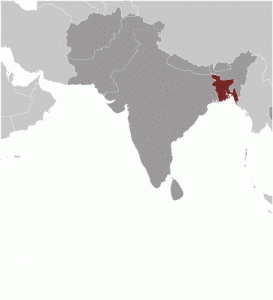 fighting, exacerbated the conflict. East Pakistan, in the Eastern part of the Bengal region, was predominantly Muslim, while the western Bengal region in India was Hindu. Minorities of Hindus and Muslims ended up on both sides of the border lines (New World Encyclopedia). Residents of East Pakistan started to feel underrepresented and exploited by their Western Pakistani counterparts. Independence for East Pakistan from West Pakistan, fueled by a rise in Bengali nationalism and the desire for independence, was gained in 1971, following an independence war in which an estimated 300,000 people died (figures are still disputed due to censorship during the war) (World Factbook). The diaspora of Bangladeshi people across Europe and the United States is often written about along with the “myth of return” in postcolonial literature, as national pride and love of Bangladesh is a serious part of citizen’s lives (New World Encyclopedia).
fighting, exacerbated the conflict. East Pakistan, in the Eastern part of the Bengal region, was predominantly Muslim, while the western Bengal region in India was Hindu. Minorities of Hindus and Muslims ended up on both sides of the border lines (New World Encyclopedia). Residents of East Pakistan started to feel underrepresented and exploited by their Western Pakistani counterparts. Independence for East Pakistan from West Pakistan, fueled by a rise in Bengali nationalism and the desire for independence, was gained in 1971, following an independence war in which an estimated 300,000 people died (figures are still disputed due to censorship during the war) (World Factbook). The diaspora of Bangladeshi people across Europe and the United States is often written about along with the “myth of return” in postcolonial literature, as national pride and love of Bangladesh is a serious part of citizen’s lives (New World Encyclopedia).
Liberia
Located: West Africa, bordered by Sierra Leone, Guinea, and Cote D’Ivoire
Colonized: Settlement began in 1822; established as a republic in 1847
Liberia is unique because it was not a part of the British Empire. Instead, the modern Liberian state was established by freed black enslaved people from the United States. Their new development was privately sponsored by American charity and church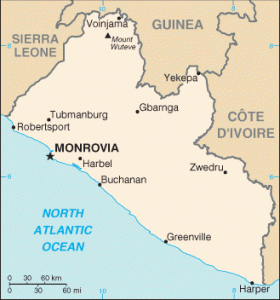 groups. The colonizers of Liberia considered themselves Americans and were recognized as such by indigenous African people and British colonizers in Sierra Leone. The settlers viewed themselves as socially more in line with the colonial British and French, and saw indigenous African tribes as uncivilized. This lead to a continuing social struggle between indigenous people and “Americo-Liberians” (New World Encyclopedia). Current president Ellen Johnson-Sirleaf, a descendent of the first indigenous Liberian to take part in the country’s government, is working to bridge social and economic gaps in the country (World Factbook).
groups. The colonizers of Liberia considered themselves Americans and were recognized as such by indigenous African people and British colonizers in Sierra Leone. The settlers viewed themselves as socially more in line with the colonial British and French, and saw indigenous African tribes as uncivilized. This lead to a continuing social struggle between indigenous people and “Americo-Liberians” (New World Encyclopedia). Current president Ellen Johnson-Sirleaf, a descendent of the first indigenous Liberian to take part in the country’s government, is working to bridge social and economic gaps in the country (World Factbook).
Ghana
Located: West Africa, bordered by Burkina Faso, Togo, Côte D’Ivoire, and the Gulf of Guinea
Colonized: 1874 (Gold Coast established as a crown colony)
Gained Independence: 1957
Formed by the merger of Gold Coast with Togoland, Ghana was the first sub-Saharan country to gain independence from Britain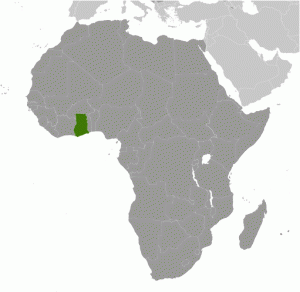 in colonial Africa (World Factbook). The country’s name is tribute to the ancient Empire of Ghana that once ruled much of Africa. The coastline was heavily used by European colonizers for shipping off black slaves (which happened for over 400 years) and for the gold trade. After contact with Portuguese traders in the 15th century, over 6 million slaves were shipped to the New World in the booming international slave trade. Ghana is still a large gold producer in Africa, and is the second biggest gold exporter on the continent. Nevertheless, the country struggles with illegal drug trades and is one of the poorest in the world (New World Encyclopedia).
in colonial Africa (World Factbook). The country’s name is tribute to the ancient Empire of Ghana that once ruled much of Africa. The coastline was heavily used by European colonizers for shipping off black slaves (which happened for over 400 years) and for the gold trade. After contact with Portuguese traders in the 15th century, over 6 million slaves were shipped to the New World in the booming international slave trade. Ghana is still a large gold producer in Africa, and is the second biggest gold exporter on the continent. Nevertheless, the country struggles with illegal drug trades and is one of the poorest in the world (New World Encyclopedia).
Hong Kong
Located: Eastern side of the Pearl River Delta, bordering the Guangdong province of China in the north and facing the South China Sea in the east, south, and west
Colonized: Became a crown colony 1842
Gained Independence: Sovereignty was transferred to the People’s Republic of China in 1997
Hong Kong was occupied by the British in 1841 and formerly ceded by China to the British Empire in 1842 (World Factbook). Hong Kong was used as a trading port in the British Empire and became a booming international trade hub. Massive 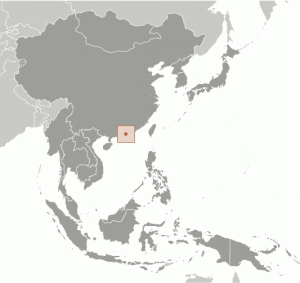 industrialization movements from the 1960s-1990s gave Hong Kong a ranking in the “Four Asian Tigers” of economic growth. Transfer of Hong Kong’s sovereignty from Britain to China is considered “the sun finally setting on Empire,” as it was the last colony that Britain gave up from its original Empire. Commonly referred to as “the Handover,” the transfer started on June 30, 1997. According to the Sino-British Joint Declaration, Hong Kong will have a “high degree of autonomy” until 2047 (New World Encyclopedia). China, a socialist country, claimed in the declaration that it would not try to interfere with Hong Kong’s capitalist economy (World Factbook). The territory includes over 260 islands (New World Encyclopedia).
industrialization movements from the 1960s-1990s gave Hong Kong a ranking in the “Four Asian Tigers” of economic growth. Transfer of Hong Kong’s sovereignty from Britain to China is considered “the sun finally setting on Empire,” as it was the last colony that Britain gave up from its original Empire. Commonly referred to as “the Handover,” the transfer started on June 30, 1997. According to the Sino-British Joint Declaration, Hong Kong will have a “high degree of autonomy” until 2047 (New World Encyclopedia). China, a socialist country, claimed in the declaration that it would not try to interfere with Hong Kong’s capitalist economy (World Factbook). The territory includes over 260 islands (New World Encyclopedia).
Zanzibar
Located: 22 miles off the coast of East Africa (Tanzania) in the Indian Ocean
Colonized: Became a protectorate of the British Empire in 1890
Gained Independence: Gained independence in 1963; united with Tanzania (formerly Tanganyika, a British colony) in 1964 to created the United Republic of Tanzania
Never a colony, but instead a protectorate, the islands comprising Zanzibar are sometimes called the “Spice Islands” because of 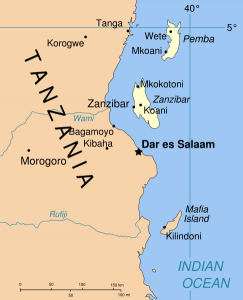 their illustrious history in the colonial spice trade. This made it desirable for colonial interests dating from the Age of Exploration, though Arabs had ports there earlier that were used to trade with East African countries. Zanzibar City (also known as Stone Town, a UNESCO World Heritage Site) was the main trading port for the Arab-controlled East African slave trade. Part of Britain’s desire to control the islands stemmed from the 19th century movements to abolish slave trades. The Empire wanted to place the islands under their control so they could control the economic activity of them (New World Encyclopedia).
their illustrious history in the colonial spice trade. This made it desirable for colonial interests dating from the Age of Exploration, though Arabs had ports there earlier that were used to trade with East African countries. Zanzibar City (also known as Stone Town, a UNESCO World Heritage Site) was the main trading port for the Arab-controlled East African slave trade. Part of Britain’s desire to control the islands stemmed from the 19th century movements to abolish slave trades. The Empire wanted to place the islands under their control so they could control the economic activity of them (New World Encyclopedia).
Guyana
Located: Northern South America between Suriname and Venezuela; borders the Atlantic Ocean
Colonized: 1815
Gained Independence: 1966
Guyana was colonized by the Dutch in the 17th century and was ceded by the Dutch to the British in 1814. The Dutch used the colony for sugar, cocoa, and coffee. After slavery was abolished throughout the British Empire in 1834, former slaves settled in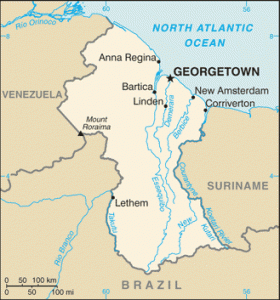 urban areas of Guyana and Portuguese, Irish, German, Scottish, Indian, Chinese, and Maltese indentured servants were shipped over to tend the sugar plantations (World Factbook). Guyana was made a crown colony in 1928 because of labor and class struggles causing rising levels of unrest. In the 1950s, increasing unrest was caused by the People’s Progressive Party turning Guyana into what the British and United States called “another Cuba” with their strong socialist views. Guyana gained independence in 1966 and became a republic in 1970, though remains a member of the commonwealth (New World Encyclopedia). Their per capita GDP is currently estimated by the World Bank at $3,739.47 , the byproduct of years of socialism and nationalised industries.
urban areas of Guyana and Portuguese, Irish, German, Scottish, Indian, Chinese, and Maltese indentured servants were shipped over to tend the sugar plantations (World Factbook). Guyana was made a crown colony in 1928 because of labor and class struggles causing rising levels of unrest. In the 1950s, increasing unrest was caused by the People’s Progressive Party turning Guyana into what the British and United States called “another Cuba” with their strong socialist views. Guyana gained independence in 1966 and became a republic in 1970, though remains a member of the commonwealth (New World Encyclopedia). Their per capita GDP is currently estimated by the World Bank at $3,739.47 , the byproduct of years of socialism and nationalised industries.
Sources used:
New World Encyclopedia. Media Wiki. Updated 13 March 2016. Accessed 6 March 2017. http://www.newworldencyclopedia.org/entry/Info:Main_Page
The World Factbook. Central Intelligence Agency. Accessed 6 March 2017. https://www.cia.gov/index.html
Pictures courtesy of World Factbook and New World Encyclopedia/Wikipedia Commons
Additional Information on Certain Cities in Relation to the British Empire:
New York City:
NYC once was part of the British Empire with the American colonies, giving it a unique side to the story. It was part of what was known as the Province of New York, and out of the empire’s cities, was behind only London and Philadelphia in size. New York’s colony also switched hands to the Dutch briefly in 1673 (New Amsterdam), but was again made English the following year. The American colonies gained their independence from Britain in 1776, and therefore the city of New York with them. (Luscombe, “North America: New York”).
New York University, NYU, has a Postcolonial, Race, and Diaspora Studies Colloquium that covers international material and that of America, and spans multiple subject areas and disciplines. (“Postcolonial, Race, and Diaspora Studies Colloquium–at New York University”).
As a city with its own strong cultural background, that impressed its own hardships upon immigrants and those in search of opportunity, New York has seen many similar stories as Britain, but under different circumstances. New York’s immigrants’ stories do not largely revolve around America in the “Mother Country” role that England is in. New York, rather, is an entirely new place–one with different schooling systems, a law and an economy run by a different government, a different language, and different expectations of assimilation.
London:
London has literally seen the British Empire through it all. Being a part of the Mother Country, London has been central to Britain’s role as an empire and as a colonizer.
One of London’s most important involvements with the empire is actually postcolonial–it was the city that greeted immigrants from the West Indies after World War II, around the 1950s. Immigrants came, many from the Empire Windrush, to London after the city was bombed and much of it destroyed by the Germans during the war. Many of these people sought to help England how they could–help to rebuild, to strengthen the workforce, to repair the city. But they were not greeted as the Brits they came as–instead, as “others,” as “problems,” as a newspaper actually referred to the immigrants. (Luscombe, “The British Empire”).
London, with its many neighborhoods and areas, such as Brick Lane, holds a multitude of cultures, stories, and histories of those who have lived there. Brick Lane, among other places in London, holds a complex history that contributes greatly to the city itself. (Duckett, Ramaswamy).
Works Consulted
Duckett, Laura. “How Brick Lane Got Its Name.” Londonist. N.p., 12 Dec. 2016. Web. 13 Apr.
Luscombe, Stephen. “Entering and Exiting the Empire.” British Empire. N.p., n.d. Web. 13 Apr.
Luscombe, Stephen. “North America: New York.” The British Empire. N.p., n.d. Web. 13 Apr.
Luscombe, Stephen. “The British Empire.” The British Empire. N.p., n.d. Web. 13 Apr. 2017.
<http://www.britishempire.co.uk/>.
“Postcolonial, Race, and Diaspora Studies Colloquium–at New York University.” WordPress,
Spring 2016. Web. 13 Apr. 2017. <https://wp.nyu.edu/nyupoco/>.
Ramaswamy, Chitra. “Brick Lane in the 80s: before it became Banglatown.” The Guardian.
Guardian News and Media Limited, 6 Mar. 2017. Web. 13 Apr. 2017.
<https://www.theguardian.com/cities/2017/mar/06/brick-lane-in-the-80s-before-it-became-banglatown>.